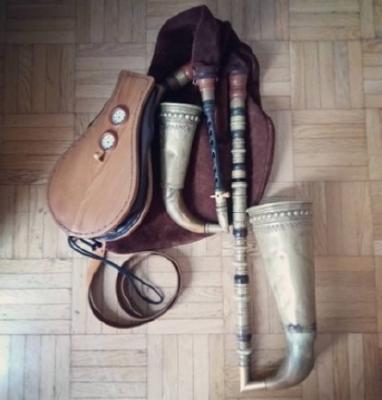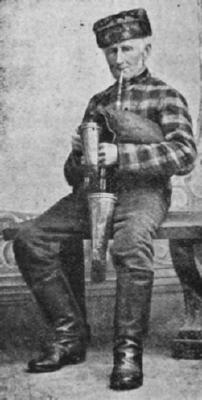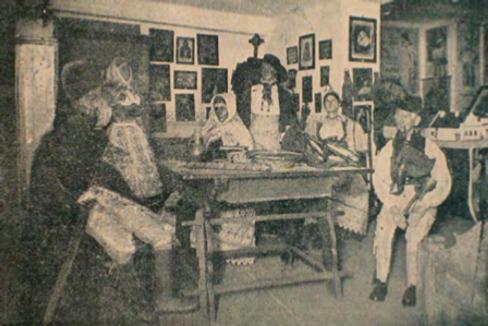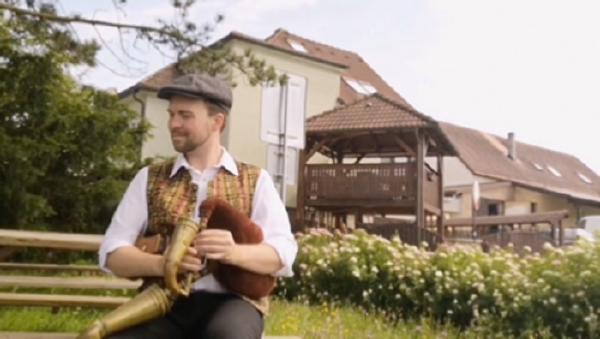The Bagpipe Society
The Tailor Piper
I have played bagpipes now for 25 years, with most of that time devoted to the Bock – a type of bagpipe which emerged in the Slavic-German contact zones during the early 17th century. Bohemia, which today is part of the Czech Republic, became a safe haven of piping in the 20th century, when bagpipes had vanished in neighbouring Germany and Austria. Both Czechs and Germans (the latter in a district called Egerland/Chebsko) used the instrument to play music for public dances and weddings.
After the expulsion of Germans from Czechoslovakia in 1946, what was left of their piping culture quickly faded into oblivion. It was only during the 1970s and 1980s that bagpipes gradually reappeared in German folk music. In Austria, the personal connections that piping pioneer Rudolf Lughofer had with Bohemia lead to a strong influence of the Czech piping scene – even before the Iron Curtain was finally lifted in 1989. This is fitting on many levels, considering the shared long history of the lands that are today Austria and the Czech Republic, the musical and cultural exchanges between them, and the ties that many families have from one region to the other.
As my grandmother was born almost a century ago in Bohemia, my ties with this region have always been very emotional. When I took up the pipes and learned they had been in use at a time when my grandmother was still living in Czechoslovakia, my personal connection with this land intensified. Since 2000, I have played at every edition of the International Bagpipe Festival, which is held every two years in the town of Strakonice. Therefore, it was only logical to accept the first invitation to play publicly since the start of the pandemic. In June, Rudolf Lughofer called me and said I should accompany him to the town of Soběslav in July. Rudolf, who is also my godfather, had taught me to play the Bock over twenty years ago. He had been invited to play some short tunes with his grandson during a brass band festival. However, there was a specific reason why I was to accompany them, but to uncover it, I need to invite you on a little detour.
Viking Horns
Back in the early 1990s, Rudolf Lughofer visited a flea market in Wels, a town in Upper Austria close to his home town of Kremsmünster. An old farmhouse had been torn down, and any saleable items had ended up at that market. Among many shabby old things, Rudolf spied something he immediately recognised to be a rarity: A rather small bagpipe, beautifully crafted and clearly very, very old. His first guess placed it about two centuries ago, which later turned out to be correct. It had one chanter, one drone pipe, and one blowpipe. It was one of the older types of small Bock-like bagpipes that had been played in South Bohemia until the early 20th century.
These instruments were usually high-pitched, used single reeds in both pipes, were mouth-blown, and had embellished cow horns as bells. The larger Bock specimen usually were bellows-blown; they also featured a rectangular extension of the drone stock, so the drone would point downward on the player’s back; additionally, they had the chanter stock carved into the shape of a goat head. These features were absent in these smaller pipes.
Rudolf realised how lucky he was to have found it. Hiding both his knowledge and excitement, he bought the instrument for 180 Austrian schillings – at that time the equivalent of roughly 15 Euros. Why the low price? First, the people selling it clearly had no idea what they had there, and the horns were missing. With his new treasure, Rudolf continued to promenade the market – and as if the find of this bagpipe hadn’t been enough of a miracle, he spotted something on one of the other desks. There lay two items which he immediately identified as the missing horns of the bagpipe he had just bought, and he got them for another few schillings. The people selling them had figured they might be some old Viking drinking horns.
Restoration
Years later, we discovered that the chanter and drone were still in very good and restorable condition. With the help of two bagpipe makers, masters Pavel Číp from Moravia (Czech Republic) and Thomas Rezanka from Upper Austria, the bagpipe was carefully turned into a playable instrument. The original stocks were copied, a bag was made, and bellows were added to keep the instrument dry. The reeds first came from Číp’s workshop, before I made my own from cane and then elder some years later. It plays best in Eb major, but the exact tuning may be adjusted within a half-step up or down, depending on the exact reed adjustment. Rudolf left it in my possession to be actively played. The chanter scale turned out to be not exactly what one with “modern ears” would suspect. Depending on the reeds, the fourth is sharp, and the leading note below the tonic is always flat by ca. 20 cent. The chanter features a major scale in plagal mode, from the dominant to the sixth above the tonic, omitting the lower sixth – but with the leading note and the fourth positioned at neutral positions, the scale effectively has no true half steps. Though this might seem odd at first, it works perfectly well with the repertoire associated with these bagpipes, and it is a feature which can be encountered similarly on other old (and sometimes contemporary) chanters across Europe.
The instrument is a fantastic example of rural craftsmanship, displaying rich ornamentation and several different types of wood (blackwood for the chanter, cherry for the stocks and drone) and other materials (brass and bone rings). Through the extensive research work of American researcher and piper Michael Cwach (“Bagpipes in the Blata Region of Bohemia”, master thesis, University of South Dakota, 2007), it was possible to date the instrument to the first three decades of the 19th century, possibly even the late 18th century, by cross-referencing it with other bagpipes kept in museums in the Czech Republic and Germany. Cwach’s research on this type of bagpipe has shown that over a dozen of similarly made bagpipes have survived – they were either made in the same workshop or at least within the school of making, maybe different generations of a family business. Cwach also proposes that these bagpipes were not made by only one person, but rather assembled from the work of several professionals (woodturners, saddlers, blacksmiths, etc.). This would explain why no single maker’s name can be identified, even though a considerable number of very similar instruments has survived.
The Tailor Piper of Soběslav
On December 12th, 1822, a baby boy was born into the Kopšík family in the small village of Čeraz, close to the town of Soběslav. The boy was baptized on the name of Franz (later, in Czech, František). He eventually took up his father’s business and became a tailor; he also learned how to play the violin from him. In an article from January 1907 (“Staré i nové zvěsti ze Soběslavě a okolí”, Old and New Stories from Soběslav and its Surroundings), Kopšík was quoted as follows (translated by Michael Cwach): “My father only taught me to play the violin. But I knew that he always played with some farmer. I went to the farmer with a bottle of liquor. He would play the violin and I would play the bagpipe accordingly. A number of times I played for free when I was learning. Since I was 17 I have been playing music in the pubs. Afterwards my brother, Bartoloměj, learned to play and the two of us played together.”

The Kopšík brothers became well known musicians; František turned out to be a fantastic piper and in his own lifetime became a popular representative of the traditional music of the Blata region, in which Soběslav lies. A mannequin modelled after him was even included in a museum exhibition. After he had become a widower, he gave up tailoring and became an innkeeper. He eventually settled in the village of Klenovice, just a few kilometres from Soběslav. In his old days, he left the , pub to be run by his son-in-law, but still resided there in a room and would play his pipes.

photographed in 1908 \(“Staré i nové
zvěsti ze Soběslavě a okolí” 1908:
104, quoted after Cwach 2007: 90\)
In 1909, Kopšík was visited by Czech composer and aesthetician Otakar Zich together with a recording team of the Imperial Academy of Sciences. In his 87th year, Kopšík was finally captured in sound on an Edison phonograph. During the sessions, he recorded no less than 18 tunes, some of which are improvisations or maybe compositions of his own, but mostly traditional dance songs from his heyday. These recordings have all survived both world wars and were finally remastered and published on CD in 2001.
Despite being in his ninth decade, Kopšík still was able to produce a lively style with lots of embellishments, sometimes stopping the pipes altogether at crucial points of the melody to create further melodic and rhythmic tension. It is still possible to hear how people would have been virtually urged to dance by this style.

Soběslav in 1908 \(Staré i nové zvěsti ze Soběslavě a okolí 2012, quoted
after Cwach 2007: 85\)
František Kopšík died in Klenovice on March 19th, 1915, some months after his 92nd birthday, at the inn which had become his home. It is possible that this was also the place where his playing was recorded on wax cylinders 112 years ago. Kopšík’s recordings are nothing less than astonishing, as they allow us a glimpse into the bagpipe culture of the first half of the 19th century, when he became “musically socialized”. This piper grew up when the Napoleonic wars were just a little over a decade away, he lived through the reigns of three emperors, his masters had been born mostly in the 18th century. Thus, František Kopšík likely is the earliest-born piper to have been recorded in sound, and possibly one of very few whose style may justly be traced back to the times of Mozart.
Sightseeing
All of this culminated in my invitation to join Rudolf Lughofer on stage in Soběslav. He specifically asked me to take along the old bagpipe he had found 30 years ago. Years ago, Rudolf had shown me a photograph of a “South-Bohemian bagpiper” in an old German book – he had bought the book because the piper seemed to play “his” old bagpipe. Later, it turned out this was a photograph of none other than František Kopšík, and the bagpipe was indeed very similar to Rudolf’s old one. Kopšík had willed his bagpipe to the local museum (Blatské muzeum), where it is still on display.
It is clear that both were either made by the same maker or at least belong to the same bagpipe making school Cwach has written about.
Incidentally, the flat leading note which is present on my old set can be heard in Kopšík’s recordings as well.

Though František Kopšík was perhaps the most famous of the Blata pipers due to his virtuosity and longevity, he was by far not the only one. Michael Cwach has managed to gather the names of various local pipers from the 19th century. All of them had to get their bagpipes from somewhere nearby, as self-making obviously was not the norm. Cwach’s research has shown that this bagpipe likely originated from a town environment, and Soběslav as own of the major towns of the Blata region is a very likely candidate.
So, when I arrived there in July to play at the brass band festival, I had already planned for a trip to the museum with the old set. I quickly found Mr.
Kopšík’s pipes – the chanter and blowpipe have been assembled into each other’s stock, but aside from this error the instrument still possesses a majesty which tells of the great craftsmanship that was put into it 200 years ago. Bringing these two instruments together was nothing short of a magic moment.
Later that day, I met with Irena Novotná, a bagpiper from Strakonice, who was unexpectedly accompanied by none other than Michael Cwach. After I had played for a lovely audience who seemed to be very aware that their town had once been home to the famous piper Kopšík, Michael and Irena invited me on a small trip. We drove to Čeraz, just outside of town. Following Michael’s direction, we ended up at an old farmhouse which was uninhabited and seemed to be on the verge of being torn down – but it did have the number four written above its entrance, and Michael confirmed that this was where the Tailor Piper of Soběslav had been born almost two centuries ago.
After this, we drove some more kilometres to Klenovice. Today, the inn where Kopšík had resided until his death is a private home. Michael told me that some years ago, the owner still could tell stories about Kopsík. A small chat with the current owners revealed that they only had a vague idea of him, but they did know that the house had been the local inn. I took the chance and recorded a short video in the backyard, playing one of the tunes on my old set which Kopšík had played there 112 years ago. Rudolf’s invitation had paid off in many ways, and it turned out to be a touching experience. Tracing this piper’s life with an instrument similar to his in my pocket was mesmerizing, and we all agreed on the spot that 2022 should see some action in his honour. It will be Kopšík’s 200th birthday in December, and what better way to celebrate a piper than by playing him some tunes? I for one sure hope that the inns of Soběslav will hear some piping again.

- Data Processing Notice (GDPR)
@BagpipeSociety on X (formally known as Twitter)
TheBagpipeSociety on Instagram
 BagpipeSociety on Facebook
BagpipeSociety on Facebook
Something wrong or missing from this page? Let us know!
